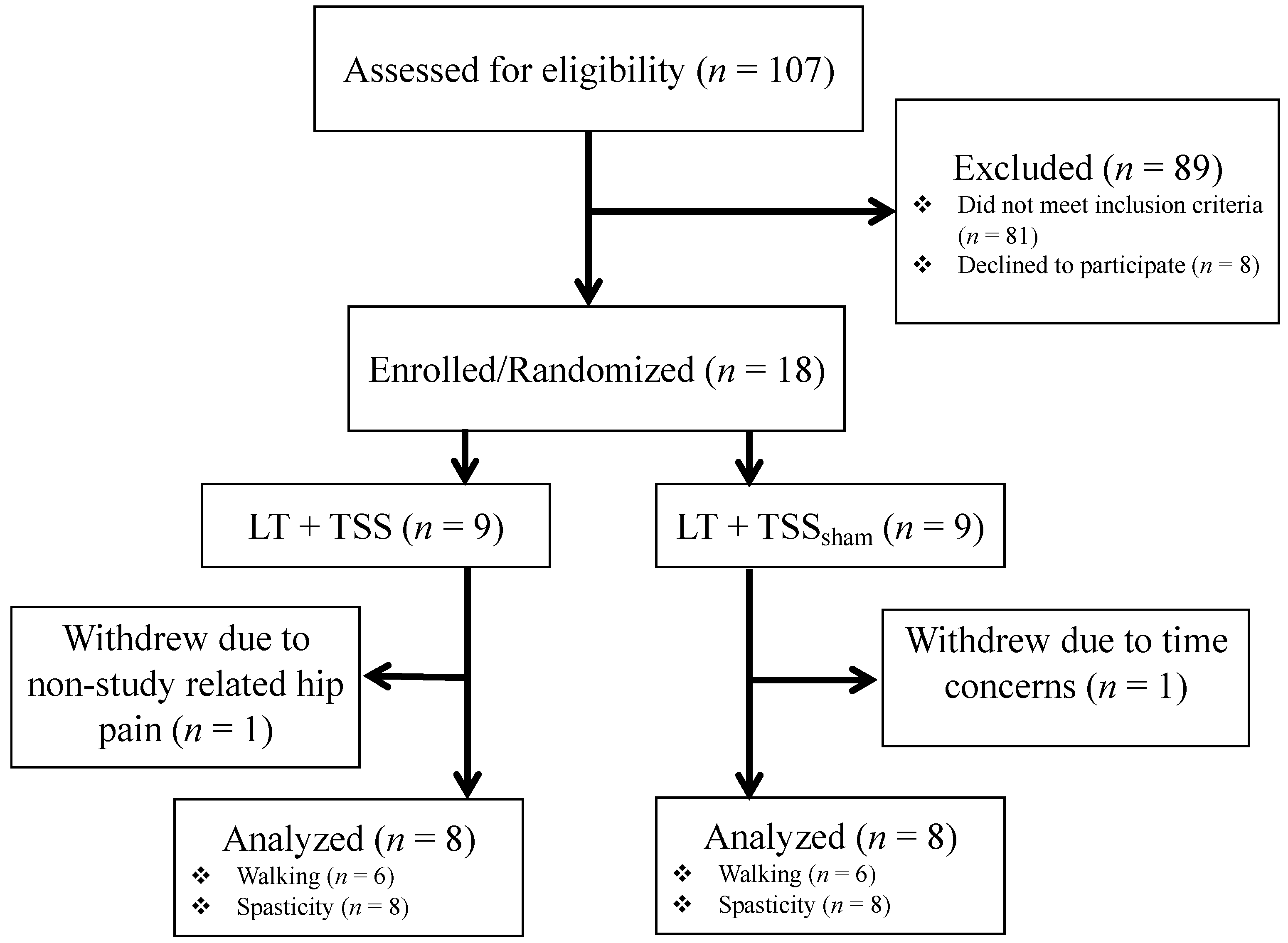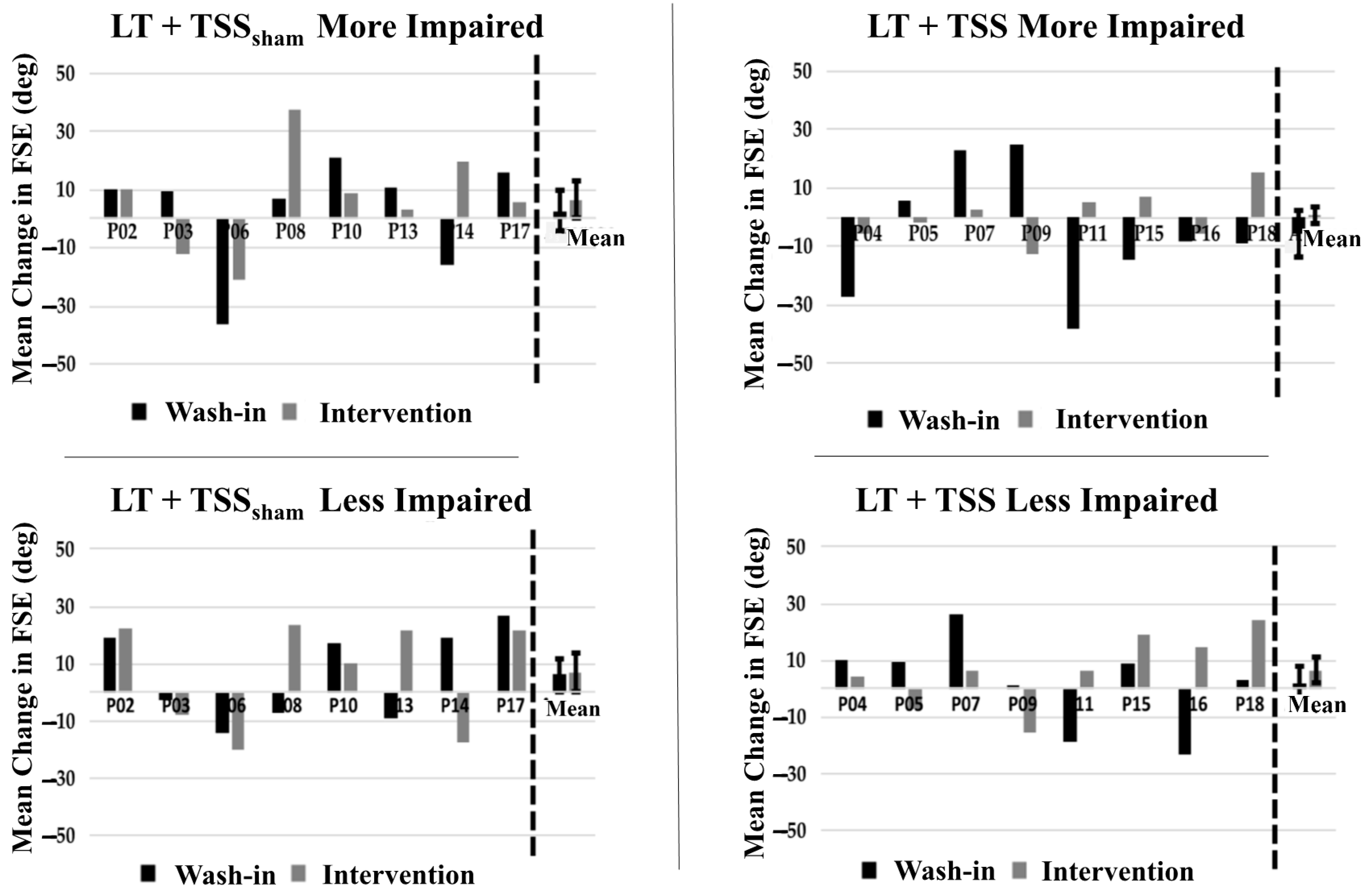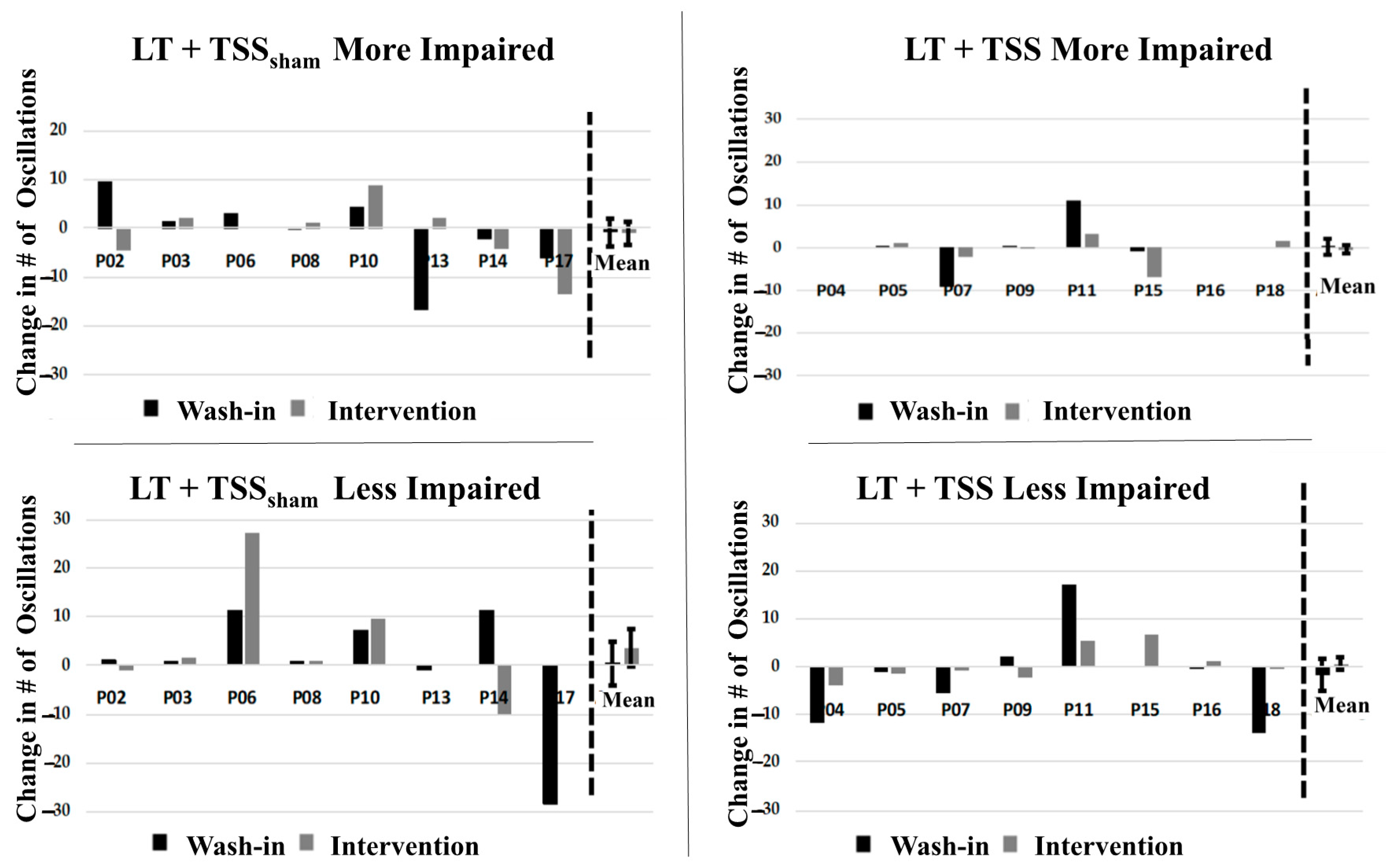Combined Transcutaneous Spinal Stimulation and Locomotor Training to Improve Walking Function and Reduce Spasticity in Subacute Spinal Cord Injury: A Randomized Study of Clinical Feasibility and Efficacy
Abstract
1. Introduction
2. Materials and Methods
2.1. Subjects
2.2. Study Design
2.3. Intervention
2.4. Outcome Measures
2.4.1. Walking Assessments
2.4.2. Spasticity Assessments
2.4.3. Pre/Post-Training Assessments
2.5. Data Analysis
3. Results
3.1. Feasibility
3.2. Effects of TSS on Walking Ability
3.3. Effects of TSS on Spasticity
4. Discussion
4.1. Feasibility
Integration into Clinical Practice
4.2. Safety and Tolerability
4.3. Preliminary Efficacy—Walking Function
4.4. Preliminary Efficacy—Spasticity
4.5. Limitations
5. Conclusions
Author Contributions
Funding
Institutional Review Board Statement
Informed Consent Statement
Data Availability Statement
Acknowledgments
Conflicts of Interest
References
- Field-Fote, E.C. Therapeutic Interventions to Improve Mobility with Spinal Cord Injury Related Upper Motor Neuron Syndromes. Phys. Med. Rehabil. Clin. N. Am. 2020, 31, 437–453. [Google Scholar] [CrossRef]
- Smith, A.C.; Knikou, M. A Review on Locomotor Training after Spinal Cord Injury: Reorganization of Spinal Neuronal Circuits and Recovery of Motor Function. Neural. Plast. 2016, 2016, 1216258. [Google Scholar] [CrossRef]
- Mehrholz, J.; Harvey, L.A.; Thomas, S.; Elsner, B. Is body-weight-supported treadmill training or robotic-assisted gait training superior to overground gait training and other forms of physiotherapy in people with spinal cord injury? A systematic review. Spinal Cord 2017, 55, 722–729. [Google Scholar] [CrossRef]
- Powell, E.S.; Carrico, C.; Raithatha, R.; Salyers, E.; Ward, A.; Sawaki, L. Transvertebral direct current stimulation paired with locomotor training in chronic spinal cord injury: A case study. NeuroRehabilitation 2016, 38, 27–35. [Google Scholar] [CrossRef]
- Hofstoetter, U.S.; Krenn, M.; Danner, S.M.; Hofer, C.; Kern, H.; Mckay, W.B.; Mayr, W.; Minassian, K. Augmentation of voluntary locomotor activity by transcutaneous spinal cord stimulation in motor-incomplete spinal cord-injured individuals. Artif. Organs 2015, 39, E176–E186. [Google Scholar] [CrossRef] [PubMed]
- Shapkova, E.Y.; Pismennaya, E.V.; Emelyannikov, D.V.; Ivanenko, Y. Exoskeleton Walk Training in Paralyzed Individuals Benefits From Transcutaneous Lumbar Cord Tonic Electrical Stimulation. Front. Neurosci. 2020, 14, 416. [Google Scholar] [CrossRef]
- Carhart, M.R.; He, J.; Herman, R.; D’Luzansky, S.; Willis, W.T. Epidural spinal-cord stimulation facilitates recovery of functional walking following incomplete spinal-cord injury. IEEE Trans. Neural. Syst. Rehabil. Eng. 2004, 12, 32–42. [Google Scholar] [CrossRef] [PubMed]
- Wagner, F.B.; Mignardot, J.-B.; Le Goff-Mignardot, C.G.; Demesmaeker, R.; Komi, S.; Capogrosso, M.; Rowald, A.; Seáñez, I.; Caban, M.; Pirondini, E.; et al. Targeted neurotechnology restores walking in humans with spinal cord injury. Nature 2018, 563, 65–71. [Google Scholar] [CrossRef] [PubMed]
- Angeli, C.A.; Edgerton, V.R.; Gerasimenko, Y.P.; Harkema, S.J. Altering spinal cord excitability enables voluntary movements after chronic complete paralysis in humans. Brain 2014, 137, 1394–1409. [Google Scholar] [CrossRef] [PubMed]
- Danner, S.M.; Hofstoetter, U.S.; Ladenbauer, J.; Rattay, F.; Minassian, K. Can the human lumbar posterior columns be stimulated by transcutaneous spinal cord stimulation? A modeling study. Artif. Organs 2011, 35, 257–262. [Google Scholar] [CrossRef]
- Hofstoetter, U.S.; Freundl, B.; Binder, H.; Minassian, K. Common neural structures activated by epidural and transcutaneous lumbar spinal cord stimulation: Elicitation of posterior root-muscle reflexes. PLoS ONE 2018, 13, e0192013. [Google Scholar] [CrossRef]
- McHugh, L.V.; Miller, A.A.; Leech, K.A.; Salorio, C.; Martin, R.H. Feasibility and utility of transcutaneous spinal cord stimulation combined with walking-based therapy for people with motor incomplete spinal cord injury. Spinal Cord Ser. Cases 2020, 6, 104. [Google Scholar] [CrossRef]
- Maynard, F.M.; Karunas, R.S.; Waring, W.P. Epidemiology of spasticity following traumatic spinal cord injury. Arch. Phys. Med. Rehabil. 1990, 71, 566–569. [Google Scholar] [PubMed]
- Pandyan, A.D.; Gregoric, M.; Barnes, M.P.; Wood, D.; Van Wijck, F.; Burridge, J.; Hermens, H.; Johnson, G.R. Spasticity: Clinical perceptions, neurological realities and meaningful measurement. Disabil. Rehabil. 2005, 27, 2–6. [Google Scholar] [CrossRef]
- Jorgensen, S.; Iwarsson, S.; Lexell, J. Secondary Health Conditions, Activity Limitations, and Life Satisfaction in Older Adults With Long-Term Spinal Cord Injury. PM R 2017, 9, 356–366. [Google Scholar] [CrossRef]
- Krawetz, P.; Nance, P. Gait analysis of spinal cord injured subjects: Effects of injury level and spasticity. Arch. Phys. Med. Rehabil. 1996, 77, 635–638. [Google Scholar] [CrossRef]
- Tibbett, J.A.; Field-Fote, E.C.; Thomas, C.K.; Widerström-Noga, E.G. Spasticity and Pain after Spinal Cord Injury: Impact on Daily Life and the Influence of Psychological Factors. PM R 2020. [Google Scholar] [CrossRef] [PubMed]
- Taricco, M.; Pagliacci, M.C.; Telaro, E.; Adone, R. Pharmacological interventions for spasticity following spinal cord injury: Results of a Cochrane systematic review. Eur. Medicophys. 2006, 42, 5–15. [Google Scholar]
- Montane, E.; Vallano, A.; Laporte, J.R. Oral antispastic drugs in nonprogressive neurologic diseases: A systematic review. Neurology 2004, 63, 1357–1363. [Google Scholar] [CrossRef] [PubMed]
- Field-Fote, E.C. Characterizing the Experience of Spasticity after Spinal Cord Injury: A National Survey Project of the Spinal Cord Injury Model Systems Centers. Arch. Phys. Med. Rehabil. 2020. [Google Scholar]
- Manella, K.J.; Field-Fote, E.C. Modulatory effects of locomotor training on extensor spasticity in individuals with motor-incomplete spinal cord injury. Restor. Neurol. Neurosci. 2013, 31, 633–646. [Google Scholar] [CrossRef]
- Mirbagheri, M.M. Comparison between the therapeutic effects of robotic-assisted locomotor training and an anti-spastic medication on spasticity. Annu. Int. Conf. IEEE Eng. Med. Biol. Soc. 2015, 2015, 4675–4678. [Google Scholar] [CrossRef]
- Adams, M.M.; Hicks, A.L. Comparison of the effects of body-weight-supported treadmill training and tilt-table standing on spasticity in individuals with chronic spinal cord injury. J. Spinal Cord Med. 2011, 34, 488–494. [Google Scholar] [CrossRef]
- Hofstoetter, U.S.; Freundl, B.; Danner, S.M.; Krenn, M.J.; Mayr, W.; Binder, H.; Minassian, K. Transcutaneous spinal cord stimulation induces temporary attenuation of spasticity in individuals with spinal cord injury. J. Neurotrauma 2020, 37, 481–493. [Google Scholar] [CrossRef]
- Hofstoetter, U.S.; McKay, W.B.; Tansey, K.E.; Mayr, W.; Kern, H.; Minassian, K. Modification of spasticity by transcutaneous spinal cord stimulation in individuals with incomplete spinal cord injury. J. Spinal Cord Med. 2015, 37, 202–211. [Google Scholar] [CrossRef] [PubMed]
- Dimitrijevic, M.M.; Dimitrijevic, M.R.; Illis, L.S.; Nakajima, K.; Sharkey, P.C.; Sherwood, A.M. Spinal cord stimulation for the control of spasticity in patients with chronic spinal cord injury: I. Clinical observations. Cent. Nerv. Syst. Trauma. 1986, 3, 129–144. [Google Scholar] [CrossRef] [PubMed]
- Dimitrijevic, M.M.R.; Dimitrijevic, M.M.R.; Illis, L.S.; Nakajima, K.; Sharkey, P.C.; Sherwood, A.M. Spinal cord stimulation for the control of spasticity in patients with chronic spinal cord injury: II. Neurophysiologic observations. Cent. Nerv. Syst. Trauma 1986, 3, 145–152. [Google Scholar] [CrossRef]
- Estes, S.P.; Iddings, J.A.; Field-Fote, E.C. Priming neural circuits to modulate spinal reflex excitability. Front. Neurol. 2017, 8, 17. [Google Scholar] [CrossRef] [PubMed]
- Stillman, B.; McMeeken, J. A video-based version of the pendulum test: Technique and normal response. Arch. Phys. Med. Rehabil. 1995, 76, 166–176. [Google Scholar] [CrossRef]
- Manella, K.J.; Roach, K.E.; Field-Fote, E.C. Temporal indices of ankle clonus and relationship to electrophysiologic and clinical measures in persons with spinal cord injury. J. Neurol. Phys. Ther. 2017, 41, 229–238. [Google Scholar] [CrossRef] [PubMed]
- Sweatman, W.M.; Heinemann, A.W.; Furbish, C.L.; Field-Fote, E.C. Modified PRISM and SCI-SET Self-Reported Spasticity Measures for Persons with Traumatic Spinal Cord Injury: Outcomes of a Rasch Analysis. Arch. Phys. Med. Rehabil. 2020. in review. [Google Scholar] [CrossRef]
- Benz, E.N.; Hornby, T.G.; Bode, R.K.; Scheidt, R.A.; Schmit, B.D. A physiologically based clinical measure for spastic reflexes in spinal cord injury. Arch. Phys. Med. Rehabil. 2005, 86, 52–59. [Google Scholar] [CrossRef]
- Portney, L.G.; Watkins, M.P. Foundations of Clinical Research: Applications to Practice; Pearson/Prentice Hall: Upper Saddle River, NJ, USA, 2009; Volume 892. [Google Scholar]
- Hart, T.; Bagiella, E. Design and implementation of clinical trials in rehabilitation research. Arch. Phys. Med. Rehabil. 2012, 93, S117–S126. [Google Scholar] [CrossRef] [PubMed]
- Nakagawa, S. A farewell to Bonferroni: The problems of low statistical power and publication bias. Behav. Ecol. 2004, 15, 1044–1045. [Google Scholar] [CrossRef]
- Perneger, T.V. What’s wrong with Bonferroni adjustments. BMJ 1998, 316, 1236–1238. [Google Scholar] [CrossRef] [PubMed]
- KJ, R. No adjustments are needed for multiple comparisons. Epidemiology 1990, 1, 43–46. [Google Scholar]
- Lakens, D. Calculating and reporting effect sizes to facilitate cumulative science: A practical primer for t-tests and ANOVAs. Front. Psychol. 2013, 4, 863. [Google Scholar] [CrossRef] [PubMed]
- Borenstein, M. Hypothesis Testing and Effect Size Estimation in Clinical Trials. Ann. Allergy Asthma Immunol. 1997, 78, 5–16. [Google Scholar] [CrossRef]
- Kinney, A.R.; Eakman, A.M.; Graham, J.E. Novel effect size interpretation guidelines and an evaluation of statistical power in rehabilitation research. Arch. Phys. Med. Rehabil. 2020, 101, 2219–2226. [Google Scholar] [CrossRef]
- Dobkin, B.; Apple, D.; Barbeau, H.; Basso, M.; Behrman, A.; Deforge, D.; Ditunno, J.; Dudley, G.; Elashoff, R.; Fugate, L.; et al. Weight-supported treadmill vs over-ground training for walking after acute incomplete SCI. Neurology 2006, 66, 484–493. [Google Scholar] [CrossRef]
- Platz, T.; Gillner, A.; Borgwaldt, N.; Kroll, S.; Roschka, S. Device-Training for Individuals with Thoracic and Lumbar Spinal Cord Injury Using a Powered Exoskeleton for Technically Assisted Mobility: Achievements and User Satisfaction. Biomed. Res. Int. 2016, 2016, 8459018. [Google Scholar] [CrossRef]
- Benson, I.; Hart, K.; Tussler, D.; van Middendorp, J.J. Lower-limb exoskeletons for individuals with chronic spinal cord injury: Findings from a feasibility study. Clin. Rehabil. 2016, 30, 73–84. [Google Scholar] [CrossRef] [PubMed]
- Anderson, K.D. Targeting recovery: Priorities of the spinal cord-injured population. J. Neurotrauma 2004, 21, 1371–1383. [Google Scholar] [CrossRef]
- Delgado, A.D.; Escalon, M.X.; Bryce, T.N.; Weinrauch, W.; Suarez, S.J.; Kozlowski, A.J. Safety and feasibility of exoskeleton-assisted walking during acute/sub-acute SCI in an inpatient rehabilitation facility: A single-group preliminary study. J. Spinal Cord Med. 2020, 43, 657–666. [Google Scholar] [CrossRef]
- Gagnon, D.H.; Escalona, M.J.; Vermette, M.; Carvalho, L.P.; Karelis, A.D.; Duclos, C.; Aubertin-Leheudre, M. Locomotor training using an overground robotic exoskeleton in long-term manual wheelchair users with a chronic spinal cord injury living in the community: Lessons learned from a feasibility study in terms of recruitment, attendance, learnability, performance and safety. J. Neuroeng. Rehabil. 2018, 15, 12. [Google Scholar] [CrossRef]
- Angeli, C.A.; Boakye, M.; Morton, R.A.; Vogt, J.; Benton, K.; Chen, Y.; Ferreira, C.K.; Harkema, S.J. Recovery of over-ground walking after chronic motor complete spinal cord injury. N. Engl. J. Med. 2018, 379, 1244–1250. [Google Scholar] [CrossRef] [PubMed]
- Lam, T.; Noonan, V.K.; Eng, J.J.; Team, S.R. A systematic review of functional ambulation outcome measures in spinal cord injury. Spinal Cord 2008, 46, 246–254. [Google Scholar] [CrossRef]
- Dobkin, B.H. Progressive staging of pilot studies to improve phase III trials for motor interventions. Neurorehabil. Neural Repair 2009, 23, 197–206. [Google Scholar] [CrossRef]
- Koelman, J.H.; Bour, L.J.; Hilgevoord, A.A.; van Bruggen, G.J.; Ongerboer, V.D. Soleus H-reflex tests and clinical signs of the upper motor neuron syndrome. J. Neurol. Neurosurg. Psychiatry 1993, 56, 776–781. [Google Scholar] [CrossRef] [PubMed]
- Fouad, K.; Krajacic, A.; Tetzlaff, W. Spinal cord injury and plasticity: Opportunities and challenges. Brain Res. Bull. 2011, 84, 337–342. [Google Scholar] [CrossRef]
- Dobkin, B.H.; Duncan, P.W. Should body weight-supported treadmill training and robotic-assistive steppers for locomotor training trot back to the starting gate? Neurorehabil. Neural Repair 2012, 26, 308–317. [Google Scholar] [CrossRef] [PubMed]







| Subject ID | Sex | Age (Years) | Time Since Injury (Days) | AIS | Neurological Injury Level | LEMS (R) | LEMS (L) | LEMS(Total) |
|---|---|---|---|---|---|---|---|---|
| 1 * | M | 51 | 56 | D | C4 | 20 | 17 | 37 |
| 2 | M | 43 | 80 | C | C4 | 14 | 13 | 27 |
| 3† | M | 65 | 88 | D | C5 | 20 | 22 | 42 |
| 4 | F | 53 | 36 | D | C2 | 22 | 20 | 42 |
| 5 | M | 56 | 84 | D | C4 | 20 | 24 | 44 |
| 6 | M | 37 | 103 | C | C3 | 17 | 22 | 39 |
| 7 †,‡ | F | 55 | 75 | C | C3 | 9 | 11 | 20 |
| 8 | M | 47 | 119 | D | C2 | 21 | 21 | 42 |
| 9 ‡ | M | 18 | 83 | D | C7 | 22 | 11 | 33 |
| 10 | F | 24 | 82 | C | C7 | 17 | 21 | 38 |
| 11 †,‡ | M | 32 | 121 | C | C4 | 24 | 6 | 30 |
| 12 * | M | 54 | 171 | C | C4 | 14 | 22 | 36 |
| 13 | M | 20 | 68 | D | C4 | 11 | 25 | 36 |
| 14 | M | 52 | 195 | B | T11 | 22 | 19 | 41 |
| 15 ‡ | M | 54 | 141 | D | C5 | 18 | 14 | 32 |
| 16 | M | 63 | 185 | D | C1 | 22 | 24 | 46 |
| 17 † | F | 58 | 71 | D | C6 | 8 | 22 | 30 |
| 18 | M | 18 | 47 | D | C5 | 25 | 8 | 33 |
| Wash-in Phase | Intervention Phase | |||||||||
|---|---|---|---|---|---|---|---|---|---|---|
| T1 | T2 | Difference | p-Value | Effect Size | T3 | T4 | Difference | p-Value | Effect Size | |
| Walking Assessments | ||||||||||
| Walking Speed (m/s) | ||||||||||
| LT + TSS | 0.47 (0.25) | 0.63 (0.30) | 0.16 (0.11) | 0.05 | 0.53 | 0.66 (0.38) | 0.82 (0.28) | 0.16 (0.13) | 0.03 | 0.43 |
| LT + TSSsham | 0.18 (0.08) | 0.30 (0.11) | 0.12 (0.05) | 0.03 | 1.15 | 0.32 (0.14) | 0.38 (0.21) | 0.06 (0.08) | 0.12 | 0.31 |
| Walking Distance (m) | ||||||||||
| LT + TSS | 57.07 (7.88) | 73.65 (27.64) | 16.58 (20.21) | 0.12 | 0.66 | 69.27 (28.84) | 84.52 (29.30) | 15.25 (9.81) | 0.03 | 0.48 |
| LT + TSSsham | 22.70 (2.81) | 39.13 (14.69) | 19.08 (13.17) | 0.04 | 1.35 | 45.05 (18.43) | 51.90 (23.59) | 6.85 (7.82) | 0.12 | 0.30 |
| Step Length Asymmetry (unitless) | ||||||||||
| LT + TSS | 0.54 (0.02) | 0.54 (0.02) | 0.00 (0.03) | 0.92 | 0.09 | 0.53 (0.01) | 0.53 (0.02) | 0.00 (0.02) | 0.75 | 0.13 |
| LT + TSSsham | 0.57 (0.07) | 0.54 (0.05) | −0.03 (0.06) | 0.27 | 0.49 | 0.54 (0.03) | 0.52 (0.02) | −0.02 (0.03) | 0.47 | 0.68 |
| Spasticity Assessments | ||||||||||
| Pendulum: More Impaired LE (degrees) | ||||||||||
| LT + TSS | 60.00 (11.84) | 54.61 (21.95) | −5.39 (22.32) | 0.40 | 0.29 | 54.18 (20.67) | 54.90 (15.22) | 0.72 (8.88) | 0.89 | 0.04 |
| LT + TSSsham | 60.43 (23.60) | 63.24 (18.83) | 2.81 (19.00) | 0.48 | 0.12 | 57.42 (19.74) | 63.98 (20.04) | 6.56 (18.00) | 0.40 | 0.31 |
| Pendulum: Less Impaired LE (degrees) | ||||||||||
| LT + TSS | 67.42 (20.06) | 69.47 (24.98) | 2.05 (16.09) | 0.48 | 0.09 | 64.97 (34.24) | 71.55 (27.90) | 6.58 (13.19) | 0.26 | 0.20 |
| LT + TSSsham | 60.52 (22.06) | 66.62 (19.01) | 6.10 (15.88) | 0.26 | 0.28 | 56.72 (16.86) | 63.61 (22.19) | 6.88 (18.72) | 0.16 | 0.33 |
| Ankle clonus: More Impaired LE (number of oscillations) | ||||||||||
| LT + TSS | 8.21 (7.10) | 6.54 (7.58) | −1.67 (9.62) | 0.50 | 0.21 | 9.88 (10.03) | 10.42 (11.57) | 0.54 (3.69) | 1.00 | 0.05 |
| LT + TSSsham | 14.75 (16.36) | 13.96 (16.63) | −0.79 (7.93) | 1.00 | 0.05 | 14.13 (15.83) | 13.19 (18.51) | −0.94 (6.57) | 0.74 | 0.05 |
| Ankle clonus: Less Impaired LE (number of oscillations) | ||||||||||
| LT + TSS | 4.67 (2.87) | 4.83 (4.86) | 0.17 (5.47) | 0.89 | 0.04 | 6.29 (6.62) | 5.88 (7.52) | −0.42 (3.08) | 0.92 | 0.06 |
| LT + TSSsham | 17.83 (19.04) | 18.25 (22.48) | 0.42 (12.62) | 0.23 | 0.02 | 12.38 (18.47) | 16.00 (21.97) | 3.63 (10.96) | 0.35 | 0.17 |
Publisher’s Note: MDPI stays neutral with regard to jurisdictional claims in published maps and institutional affiliations. |
© 2021 by the authors. Licensee MDPI, Basel, Switzerland. This article is an open access article distributed under the terms and conditions of the Creative Commons Attribution (CC BY) license (http://creativecommons.org/licenses/by/4.0/).
Share and Cite
Estes, S.; Zarkou, A.; Hope, J.M.; Suri, C.; Field-Fote, E.C. Combined Transcutaneous Spinal Stimulation and Locomotor Training to Improve Walking Function and Reduce Spasticity in Subacute Spinal Cord Injury: A Randomized Study of Clinical Feasibility and Efficacy. J. Clin. Med. 2021, 10, 1167. https://doi.org/10.3390/jcm10061167
Estes S, Zarkou A, Hope JM, Suri C, Field-Fote EC. Combined Transcutaneous Spinal Stimulation and Locomotor Training to Improve Walking Function and Reduce Spasticity in Subacute Spinal Cord Injury: A Randomized Study of Clinical Feasibility and Efficacy. Journal of Clinical Medicine. 2021; 10(6):1167. https://doi.org/10.3390/jcm10061167
Chicago/Turabian StyleEstes, Stephen, Anastasia Zarkou, Jasmine M. Hope, Cazmon Suri, and Edelle C. Field-Fote. 2021. "Combined Transcutaneous Spinal Stimulation and Locomotor Training to Improve Walking Function and Reduce Spasticity in Subacute Spinal Cord Injury: A Randomized Study of Clinical Feasibility and Efficacy" Journal of Clinical Medicine 10, no. 6: 1167. https://doi.org/10.3390/jcm10061167
APA StyleEstes, S., Zarkou, A., Hope, J. M., Suri, C., & Field-Fote, E. C. (2021). Combined Transcutaneous Spinal Stimulation and Locomotor Training to Improve Walking Function and Reduce Spasticity in Subacute Spinal Cord Injury: A Randomized Study of Clinical Feasibility and Efficacy. Journal of Clinical Medicine, 10(6), 1167. https://doi.org/10.3390/jcm10061167





